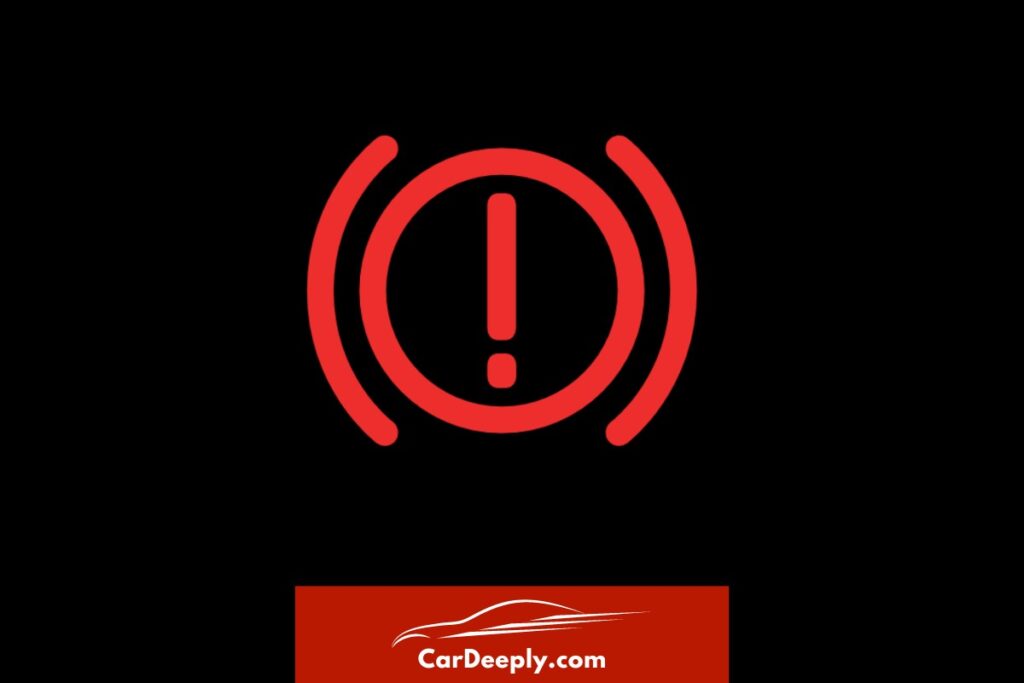When the brake warning light appears on the dashboard of your vehicle, all alarm bells should go off.
The warning light should always be addressed! It warns you of potential problems that can significantly endanger your safety and other road users.
In this article, you will learn everything you need to know about the brake warning light (causes, immediate measures, etc.) and get practical tips that you can implement immediately.
Let’s get started!
Advertising links are marked with *. We receive a small commission on sales, nothing changes for you.
Key Takeaways
- The brake warning light serves as a warning signal of potential problems in the braking system, with a red light indicating more critical issues than a yellow one.
- If the brake warning light is on, you should immediately stop and check your vehicle, the brake fluid level, the brake pads, and the ABS (if the warning light is yellow).
- Regular and, above all, complete maintenance of your vehicle’s brake system is essential to ensure safety on the road.
- Road safety depends to a large extent on the correct behavior when the brake warning light is activated.
What does the brake warning light do, and why is it so important?
The brake warning light is a small but enormously important signal on your vehicle’s dashboard.
It gives you important information about your car’s braking system.
Tip: See the meaning of all warning lights here!
What does the brake warning light look like?
The brake warning light usually shows a circle surrounded by a surrounding dash. In addition, you may also see an exclamation point.

Simple text such as “BRAKE” or “ABS” will also be displayed on older vehicle models.
Important: In most vehicles, the brake warning light comes on briefly when the engine is started and then goes out again to indicate that the system is working properly.
Red or amber warning light – what’s the difference?
The brake warning light can be either red or amber.
But what does it mean?
Simple:
- A red brake warning light signals something is wrong with the main brake system. Here you should act IMMEDIATELY because your safety and that of other road users are at stake!
- Yellow brake warning light: This light is responsible for the anti-lock braking system (ABS). If it is illuminated, the ABS may be impaired.
Causes: Why is the Brake Warning Light on in my Vehicle?
There are several reasons why the brake warning light comes on.
Here are the 3 most common causes:
- Low brake fluid level: If too little brake fluid is in your vehicle, the warning light will come on. Check and refill if necessary (more on this in a moment)!
- Worn brake pads: Worn brake pads can cause the brake warning light to come on. A look at the brake pads will tell you if they need to be replaced.
- ABS problem: If the yellow light flickers on, this indicate a problem with the ABS. You should have the ABS sensors and control units checked in this case.
Now you know 3 typical causes that activate the brake warning light.
In the next chapter, we will look at what immediate measures you should take to ensure safety.
Immediate Measures When the Brake Warning Light is on – What to do?
The brake warning light is flashing, and you’re wondering what to do.
First of all, our advice is don’t panic!
Here are some steps you can take immediately to get the situation under control quickly.
1. Safety first: Stop and check the vehicle
When the brake warning light comes on, you must immediately pull over to a safe location.
Turn off the engine and apply the parking brake.
Safety is always the priority.
2. Check the brake fluid level
A common reason for the brake warning light to come on is a low brake fluid level.
Open the hood and locate the brake fluid reservoir.
This reservoir usually consists of a clear sidewall or marker where you can read the current fluid level.
You should add brake fluid if the level is below the “Min” mark.
Use the correct fluid as specified in your car’s owner’s manual.
Note: Make sure to distinguish the brake fluid reservoir from the coolant reservoir. The coolant is usually pink in color.
3. Check brake pads
Worn brake pads can also cause the brake warning light to come on.
To check the brake pads, look through the spokes of your rims. You usually have a good view from here.
As a rule of thumb, if the brake pads are thinner than about 3 mm, you should have them replaced.
Visual inspections are inconclusive (especially if you are inexperienced in this field). Therefore, if you are unsure, visit a specialist workshop.
4. Check the ABS (if the yellow warning light is on)
The ABS is most likely affected if the yellow brake warning light is illuminated.
This means that the brakes are working, but the ABS does not provide any or only limited support.
In this case, you MUST visit a workshop. You cannot check the ABS on your own!
Long-term Solutions and Maintenance
To ensure that your braking system is always in the best possible condition, you should make regular maintenance a routine.
These maintenance procedures require little time but increase safety immensely – and protect you from unwanted brake system problems.
1. Regular check
It is important to check the braking system regularly.
This includes:
- Checking the brake fluid level
- Visual inspection of all brake pads and discs
2. Replacement of brake pads
Brake pads are wearing parts and should therefore be replaced at regular intervals.
The intervals for replacement vary depending on the manufacturer, driving style, and vehicle model.
You can find the recommended intervals in your car’s owner’s manual.
When a Professional Inspection is Necessary
Sometimes more than a simple self-check is required.
If you have doubts or the brake warning light doesn’t go away despite your best efforts, it’s time to visit a professional workshop.
Experts can thoroughly check the brake system and fix any problems.
Avoiding False Alarms and Unnecessary Costs
You must pay attention to a few points to avoid false alarms from the brake warning light and unnecessary costs incurred.
Here are our tips for getting the most out of your brake system:
1. Recognize and correct faults in the brake system.
Be alert when the brake warning light comes on, and make an initial check immediately.
By fixing small problems quickly, you’ll prevent major damage and save money in the long run.
2. Tips to extend the life of your brakes
To extend the life of your brakes, you can apply a few simple behaviors:
Avoid abrupt braking (drive with foresight).
Let the car coast slowly before a traffic light or stop sign.
Use engine braking to reduce speed without overusing the brakes.
3. Importance of regular car maintenance
Here (again) is an urgent appeal: regular vehicle maintenance can most likely save you from the brake warning light.
Make sure you do these routine checks!
Summary: What is Important for the Brake Warning Light?
In this article, we’ve covered the most important points about brake warning lights and given you the best practices to follow.
Follow our tips to ensure safety on the road. Regular maintenance and anticipatory driving will help extend brake life and avoid false alarms.
Now it’s your turn!
Feel free to share your personal experiences with the brake warning light in the comments, and let us know if you have any other tips and tricks up your sleeve.
Safety is everyone’s business – let’s work together to ensure it!

Sebastian loves convertibles and drove a BMW 335i for a long time (325 hp is just a dream). Today, with two children, he is more concerned with SUVs and family-friendly vehicles. In addition to an Audi A4 Avant, he also drives a Cupra Formentor VZ – even as a family man, you can’t do without speed. Get to know Sebastian better and visit the About Us page.
Advertising links are marked with *. We receive a small commission on sales, nothing changes for you.
